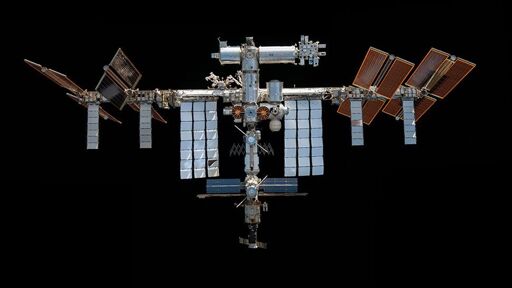Is the moon too far for your data? IBM's Red Hat is teaming up with Axiom Space to send a data center into space
-
This post did not contain any content.
I wonder what the moon’s top level domain name would be?
-
This post did not contain any content.
Seems like the moon would be close enough for our standard IPv6 TTLs to work, but it seems more likely that we will have to abandon domain names in favor of something like IPFS, since it's a resource locator instead of a location locator. If you were on Mars, for example, you would not want to have to contact Earth every single time you wanted to load a web page. And so you would contact Earth the first time to load it. And then it would be saved locally. And so anybody who requested that page in the future would talk to you instead of Earth.
-
Seems like the moon would be close enough for our standard IPv6 TTLs to work, but it seems more likely that we will have to abandon domain names in favor of something like IPFS, since it's a resource locator instead of a location locator. If you were on Mars, for example, you would not want to have to contact Earth every single time you wanted to load a web page. And so you would contact Earth the first time to load it. And then it would be saved locally. And so anybody who requested that page in the future would talk to you instead of Earth.
Sounds like some sort of decentralized federation of server resources. I don't know, seems a bit advanced. /s
-
This post did not contain any content.
INB4 chumps discover that cooling hardware in a vacuum is, in fact, quite difficult.
-
This post did not contain any content.
What would they use it for? The 2.5 seconds of latency would be too high for most uses. Cooling will be very difficult with no atmosphere. Solar power will be hard since night time lasts two weeks. Radiation will damage electronics unless they bury them.
-
INB4 chumps discover that cooling hardware in a vacuum is, in fact, quite difficult.
What if me make a heat laser? /s
-
This post did not contain any content.
Well I guess that's what it takes to make Microsoft's ocean bottom data center look reasonable.

-
Seems like the moon would be close enough for our standard IPv6 TTLs to work, but it seems more likely that we will have to abandon domain names in favor of something like IPFS, since it's a resource locator instead of a location locator. If you were on Mars, for example, you would not want to have to contact Earth every single time you wanted to load a web page. And so you would contact Earth the first time to load it. And then it would be saved locally. And so anybody who requested that page in the future would talk to you instead of Earth.
Nothing would stop you from running a DNS server on Mars and handling requests locally.
-
Nothing would stop you from running a DNS server on Mars and handling requests locally.
The problem isn't the DNS requests. It's the data synchronization that would have to occur if you were accessing a service hosted on Earth.
-
The problem isn't the DNS requests. It's the data synchronization that would have to occur if you were accessing a service hosted on Earth.
It's called caching and it's been mostly solved for decades (except invalidation).
-
What would they use it for? The 2.5 seconds of latency would be too high for most uses. Cooling will be very difficult with no atmosphere. Solar power will be hard since night time lasts two weeks. Radiation will damage electronics unless they bury them.
Anything that needs a lot of data. Same reason you'd download something to your PC instead of streaming it.
Also for local processing before upload. If you have a huge data set that compresses well, it's much better to compress first, then upload to Earth.
-
What would they use it for? The 2.5 seconds of latency would be too high for most uses. Cooling will be very difficult with no atmosphere. Solar power will be hard since night time lasts two weeks. Radiation will damage electronics unless they bury them.
No hurricanes, earthquakes, floods, or other types of disasters on the moon. Asteroids are rare enough now that they basically don't count.
Latency is high but it doesnt matter for data redundancy.
-
INB4 chumps discover that cooling hardware in a vacuum is, in fact, quite difficult.
In deep craters near the Moon's poles, permanent shadows keep the surface even colder — NASA's Lunar Reconnaissance Orbiter has measured temperatures lower than -410°F (-246°C)
-
What would they use it for? The 2.5 seconds of latency would be too high for most uses. Cooling will be very difficult with no atmosphere. Solar power will be hard since night time lasts two weeks. Radiation will damage electronics unless they bury them.
Craters at poles are in permanent shadows with -200 degrees permanently
-
In deep craters near the Moon's poles, permanent shadows keep the surface even colder — NASA's Lunar Reconnaissance Orbiter has measured temperatures lower than -410°F (-246°C)
That's not the issue, though. In a vacuum there is no medium with which to carry the heat away. You can't send it into the air with fans or heat sinks because there isn't any air.
At least on the moon you could sink it into the ground. But in orbit you don't have that luxury. This is a major problem that spacecraft and satellite designs need to work around, and much effort is expended in that department.
Even though space is generally considered "cold," in the absence of a medium to sink heat into the best you can do is rely on infrared radiation which is not terribly effective.
-
INB4 chumps discover that cooling hardware in a vacuum is, in fact, quite difficult.
Lol, this is the truth. There are many cool opportunities for industry in space, but I gotta be honest, I don't think datacenters are one of them...
-
What if me make a heat laser? /s
You joke, but actually that is a thing.
When research projects involve super-cooling a substance, after you've done as much as you can with convective cooling, researchers will sometimes use lasers to cancel out vibrations within the substance, and cancelling vibrations essentially equals cooling.
-
No hurricanes, earthquakes, floods, or other types of disasters on the moon. Asteroids are rare enough now that they basically don't count.
Latency is high but it doesnt matter for data redundancy.
Ok... Data redundancy is a possible application... I will tentatively say that's a feasible goal, if still probably a stupid one.
I mean, how often do data centers upgrade storage drives? Cause the cost of doing that in space is... unreasonable.
-
Seems like the moon would be close enough for our standard IPv6 TTLs to work, but it seems more likely that we will have to abandon domain names in favor of something like IPFS, since it's a resource locator instead of a location locator. If you were on Mars, for example, you would not want to have to contact Earth every single time you wanted to load a web page. And so you would contact Earth the first time to load it. And then it would be saved locally. And so anybody who requested that page in the future would talk to you instead of Earth.
If you were on Mars, for example, you would not want to have to contact Earth every single time you wanted to load a web page. And so you would contact Earth the first time to load it. And then it would be saved locally.
Don't ISPs already do something like this to save on bandwidth on their side? Just saving local copies of commonly accessed files.
At least I remember hearing about that a decade ago, I wonder if that can still happen now that there's basically https everywhere.
But at any rate, I believe there are at least well established methods for that.
-
That's not the issue, though. In a vacuum there is no medium with which to carry the heat away. You can't send it into the air with fans or heat sinks because there isn't any air.
At least on the moon you could sink it into the ground. But in orbit you don't have that luxury. This is a major problem that spacecraft and satellite designs need to work around, and much effort is expended in that department.
Even though space is generally considered "cold," in the absence of a medium to sink heat into the best you can do is rely on infrared radiation which is not terribly effective.
It's done for smaller parts with peltiers nowadays. Not that efficient, but there are few options. If you sink it to a large enough surface, it will radiate away.



